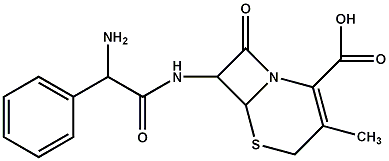Cephalexin
Cefalexin (previously also British Approved Name Cephalexin) is a drug that is a member of the cephalosporin class of antibiotics. It is one of the most widely prescribed antibiotics. more...
Indications
Cefalexin is used to treat urinary tract infections, respiratory tract infections (including sinusitis, otitis media, pharyngitis, tonsillitis and pneumonia), skin and soft tissue infections.
It is used in preference to one of the penicillin group when greater target site concentration is sought, bacterial have developed penicillin resistance, or for people allergic to a penicillin (there being only a 10% cross-over of allergy between the groups).
Formulations
Cefalexin comes as capsules or tablets of 250 or 500mg, and liquids of 125 or 250mg per 5ml. It should be taken with a full glass of water.
It is marketed under a wide range of brand names (e.g. Biocef, Cefanox, Ceporex, Keflet, Keflex, Keforal, Keftab, Keftal, and Lopilexin)
Dosage
Typical dosage is 250mg every 6 hours or 500mg every 8-12hours, and doubled in cases of severe infection. Smaller dosages are used for children based on weight or age.
Courses generally last for 7-10days, but just 3 days in the early treatment of uncomplicated urinary tract infection in women.
Precautions
Cefalexin should not be taken by those known to be allergic to other members of the Cephalosporin group. Caution is required for those with known allergic to a member of the penicillin group as there is about a 10% cross-over rate between the groups.
Being a broad-spectrum antibiotic, its effect on gut flora may interfere with the effectiveness of the oral contraceptive pill.
Side Effects
Cefalexin is generally well tolerated with stomach or bowel upset the most likely side-effect. It may also cause fatigue or headaches.
Rarely allergic reactions, e.g. itching, swelling, dizziness or trouble breathing.
As per broad-spectrum penicillins, overgrowth with oral or vaginal yeast infections may occur.
Refereneces
- FDA Drug Information PDF and Pharmacy Drug Information Insert.
- British National Formulary '50' September 2005
Read more at Wikipedia.org


